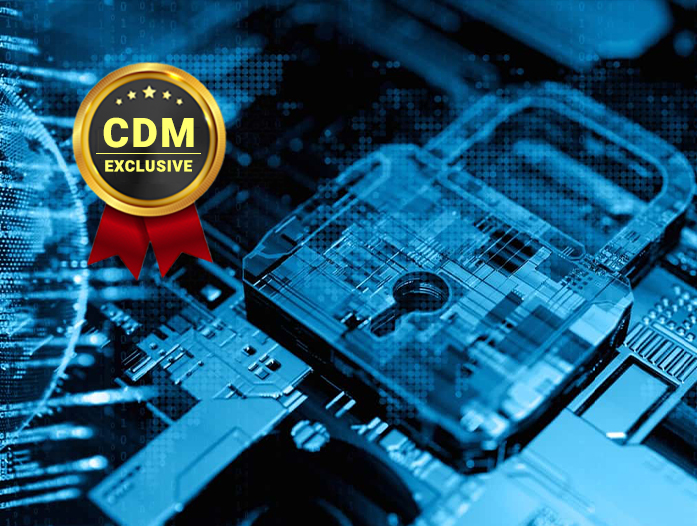What is Zero Trust security, and what are the benefits? Here’s how to prevent data breaches by staying on top of security with Zero Trust architecture.
By Harish Akali, Chief Technology Officer, ColorTokens
‘Trust Nothing, Verify Everything’: Benefits and Best Practices of Zero Trust Architecture
No matter the industry or size, organizations have been embracing digital transformation at an astonishing pace. Necessarily, the cybersecurity industry is seeing a shift that many argue is long overdue. This is best described as a paradigm shift from reactive to proactive security that assumes the bad guys will get in. This is also the paradigm of Zero Trust architecture, which is built to stop the bad guys in their tracks from the inside out if need be.
Businesses today are essentially massively interconnected attack surfaces. Meanwhile, the maximization of telework and cloud computing are supersizing the number of attack vectors. Enterprise networks with traditional security have become a playground for bad actors, who rely on taking advantage of any processes, access, or traffic that are “trusted” to stay undetected. This is where Zero Trust architecture comes into play with its credo of “trust nothing; verify everything.”
Even President Joe Biden is among the proponents of Zero Trust architecture. As this wide embrace of Zero Trust is growing, security professionals want to know how they can make Zero Trust a reality for their enterprise. Many are coming to learn that Zero Trust is a journey, and understanding this journey is the first step down the path.
If you wish to dive deeper into the topic of Zero Trust, we’ve made a FREE copy of the first and only “The Definitive Guide to Zero Trust Security“ available to all Cyber Defense Magazine readers.
First, you may be asking, ‘What is Zero Trust security?’
Zero Trust security can be summed up with the phrase, “Trust nothing, verify everything.” Resource access within a network is always limited by trust dimensions — and access is revoked if these parameters are ever unmet. It provides a 180-degree turn from traditional security models that provide implicit trust within the network.
For the most part, the principles of Zero Trust architecture can be broken down into the following components:
- Network traffic is untrusted. This is true even if traffic originates internally. Inspection, authentication, and documentation are always necessary.
- Micro-segmentation is applied. No user can roam freely throughout the infrastructure.
- Each entity is low trust. An entity will gain only a specific level of trust.
- Zero Trust doesn’t mean no trust. Upon verification, entities are given appropriate, yet restricted, access that is limited to the function they must perform.
- Trust is dynamic. Trust may be granted, but it isn’t constant.
- Trust is impartial. All users and entities will be assessed using the same criteria.
- Least privilege access always applies. Trust is granted based on what’s needed to perform the entity’s intended functions.
When each of these principles comes together, IT teams can achieve long-term cyber resiliency.
The Benefits of Zero Trust Security
- Secure cloud migrations.
IT teams gain the ability to visualize, monitor, and control network traffic with platforms like the Xtended ZeroTrust™ Platform — even those running in virtual machines and containers. If integrated with cloud management tools, Zero Trust also ensures that security policies move with workloads upon cloud migration.
- Increased visibility into lateral movements.
Threats can go unnoticed as they move laterally across networks. With the granular visibility provided by end-to-end Zero Trust platforms, IT teams gain 360-degree visibility and control of their environments.
- Data breach prevention.
By isolating high-value assets, IT teams can restrict access to all users, services, devices, and platforms other than those parties authorized as “need to know,” circumventing any widespread data breaches.
- Data breach resilience.
Legacy systems are often wide open to the network and lack the isolation necessary to limit a breach. Zero Trust architecture platforms divide systems into micro-segments, building greater cyber resilience for companies.
- Massively reduced attack surface.
Providing access to only those assets and workloads that users need creates smaller trust zones, reducing the attack surface and restricting unauthorized lateral movements should cybercriminals gain access.
- Greater compliance.
Isolating high-value assets alone strengthens compliance, but Zero Trust security also prevents unauthorized access by internal and external parties, generates privacy-related regulation documentation, and establishes a wall between development and production within an organization.
- Limited scope of compliance audit.
With segmentation being the initial step of Zero Trust security, companies limit the scope of a PCI-DSS audit by showing evidence of segmentation across the data center, cloud providers, and business locations.
- Mitigated risk from legacy systems.
For example, many of our manufacturing clients operate with legacy, end-of-life systems that aren’t replaceable or easy to upgrade for budget or business reasons. These outdated systems, however, are unpatched with no support, setting the stage for cyberattacks. Securing these legacy systems quickly and for long-term resiliency is to prevent the movement of ransomware is possible with Zero Trust.
Basic Steps of Zero Trust Implementation
Zero Trust architecture isn’t a “set-and-forget” solution to cybersecurity. As your organization begins preparing to implement Zero Trust security, it’s important to keep in mind the following:
- Map the environment.
Mapping the environment gives IT teams a clearer picture of the task ahead. With most companies containing many moving parts, start with one application or workload to get a grasp on the number of users, amount of traffic, required applications, and connections between all entities.
- Define trust zones.
Trust zones are basically data assets that should be segmented, monitored, and protected as units, falling under a set of access policies. Automation can assist in identifying trust zones by looking at workloads in the same network segment, but always make sure to have human administrators verify that zones align with business practices.
- Create security policies.
Security policies will dictate access not only to assets, but also between trust zones. Powerful policy engines will help by recommending policies, which will streamline the process.
- Observe traffic between trust zones.
Schedule an observation period to capture the traffic patterns between established trust zones. You may find that certain parties need access to perform urgent tasks, and setting authentication boundaries between these zones could impact mission-critical activities. This is part of “building the muscle,” which will get stronger over time.
- Monitor and refine zones and policies.
Applications come and go. Workflows change. Team members are always on the move. Naturally, you’ll need to track and adapt the policies that protect high-value assets. It’s important to build in some flexibility and adaptability into Zero Trust architecture and the security tools used to enforce authentication.
For the ultimate breakdown of Zero Trust best practices and implementation, download a free copy of the first and only “Definitive Guide to Zero Trust Security.”
Best Practices for Zero Trust Implementation:
With Zero Trust implementation being a new initiative, the chances are good that your organization will experience some growing pains with Zero Trust architecture. This isn’t uncommon — nor should it serve as an excuse to abandon the new measures. In our experience, these tactics can often be of benefit:
- Go zone by zone.
“Boiling the ocean” is never a good idea with Zero Trust architecture. Instead, enforce policies trust zone by trust zone. Perhaps start with your highest-value application and expand out from there.
- Use orchestration for DevOps.
Integrating DevOps with cloud infrastructure tools can help protect data, applications, and workflows within cloud platforms when moved to Zero Trust architecture.
- Update policies.
Zero Trust security is a dynamic environment. IT teams should be monitoring both policy violations and new connections that might require new policies. Update policies and enact new ones based on the findings. Again, the right policy engine can streamline this.
- Extend Zero Trust to endpoints.
The same principles should be applied to all endpoints within an organization, including servers, laptops, PCs, and mobile devices. Traffic can help to identify where to direct IT attention. Only authorized processes should run at these endpoints, thereby reducing the risk of cyberthreats.
Zero Trust architecture should do more than stitch together security protocols. It can help an organization establish a set of rules and control to determine which entities can gain access to restricted locations and critical information within a company.
Selecting the Right Zero Trust Vendor
Not all Zero Trust vendors are created equal. In fact, some tout their products and services as “Zero Trust” without following through. This makes the selection process of a Zero Trust vendor suited to your organization more important than ever. Here are just a few of the criteria to keep in mind as you arrive at a decision:
- Platform approach.
A Zero Trust architecture should span the entire network, regardless of location. So naturally, point security tools cannot achieve unified context and control and will leave organizations with a fragmented Zero Trust posture. What’s needed is a single platform that provides end-to-end Zero Trust for workloads, users, endpoints, and applications. Such platforms like the eXtended ZeroTrust™ Platform can deliver Zero Trust at scale.
- Cloud delivery.
If your organization has already made the move to the cloud, look for a Zero Trust vendor that operates on cloud platforms. This ensures that the vendor and its security platform can scale with your operations.
- Scope of capabilities.
If a vendor doesn’t enable greater visibility and micro-segmentation cloud security, move on. You need the ability to monitor the network and divide data assets to limit and respond to cyberthreats.
- Breadth of protection.
Zero Trust zones are essential to Zero Trust architecture and should offer control over a wide range of resources. Look for the capability to define user groups and create policies that control access to resources.
- Ease of implementation and management.
While Zero Trust vendors should always be on hand to offer support, the ideal choice will provide access to the security tools and resources to take internal control. Your IT team should have the capacity to classify user groups, create connection maps, adjust policies, and so on, without a call to the vendor.
- Integration of other security tools.
Zero Trust vendors should offer platforms that can share information with other security tools, including cloud service provider security; management and logging technologies; security information and event management systems; and orchestration and automation tools. Otherwise, the transition and enforcement won’t be as smooth as you’d hoped.
- Total cost of ownership.
As with anything in business, it all comes down to budget. Narrowing the field of potential Zero Trust vendors should account for more than implementation costs. Factor in licensing and maintenance costs, as well as the cost for initial implementation and ongoing connection monitoring.
Above all else, it’s important to factor in the savings you’ll gain when your operations have all the proper controls in place to protect high-value assets, applications, and other resources. The wrong choice can affect you for years to come.
If you’d like to learn more about what ColorTokens’ award-winning Zero Trust approach can do for your organization, please let us know. A member of our team would be more than happy to review your operations and develop a solution that’s customized to your critical assets.
About the Author
 Harish Akali is the Chief Technology Officer at ColorTokens , Inc., a leading innovator in SaaS-based Zero Trust cybersecurity solutions. As a member of the ColorTokens leadership team, he uses his extensive knowledge of cybersecurity and enterprise software across multiple industries to drive innovation.
Harish Akali is the Chief Technology Officer at ColorTokens , Inc., a leading innovator in SaaS-based Zero Trust cybersecurity solutions. As a member of the ColorTokens leadership team, he uses his extensive knowledge of cybersecurity and enterprise software across multiple industries to drive innovation.


